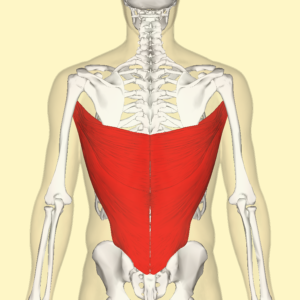
Article published in AZCentral Healthy Living
Gait is the pattern of movement that you use when you walk or run. It is an important functional movement that requires coordination of your core and limbs. Multiple muscles, tendons, ligaments and bones work synergistically to coordinate movement and stability between your lower and upper extremities during the gait cycle. The latissimus dorsi is a muscle that helps control the upper extremities. It works closely with the gluteus maximus, which helps control the lower extremities.
Latissimus Dorsi
The latissimus dorsi is the largest muscle in your body. Together, the right and left sides of the latissimus dorsi form a large triangle across your back. One corner of the triangle attaches under your right upper arm bone — your humerus — and extends across your back to your spine. A mirror image continues to the underside of your left humerus. The right and left sides come together at the spine to form the third corner of the triangle, which points downward ending at your sacrum. This muscle extends your arms at the shoulders. It also rotates and adducts your shoulders.

The Latissimus Dorsi Muscle
Dynamic Stabilization
When you walk or run, your neuromuscular system coordinates movement between your muscles and connective tissue to avoid excessive force on individual muscles or joints. The latissimus dorsi works with the gluteus maximus to stabilize your torso as you extend your back hip and push off your toes to swing that leg forward. When the gluteus maximus on your back leg activates, it extends and rotates the hip. At the same time the opposite side latissimus dorsi engages to extend and rotate your shoulder to stabilize your upper body in the opposite direction.
The Big X
Imagine a big X painted on your back, from the right shoulder to the left hip and from the left shoulder to the right hip. When you take a step, one diagonal shortens while the opposite diagonal lengthens. When your gluteus maximus engages on one side to lift your leg behind you, the opposite latissimus dorsi also engages to bring the opposite arm back. This provides stabilization of your torso, especially the sacroiliac joint.
Gait and Balance
Gait can be broken down into two primary phases: the stance phase and the swing phase. Different muscles are responsible for movement and balance during each phase. The latissimus dorsi and gluteus maximus engage during the stance phase. During the stance phase you must be able to balance over one leg. You make initial contact with your heel touching the floor in front of you, then shift your weight over the new leg. As you do this, the latissimus dorsi and gluteus maximus provide diagonal stability of your torso, shortening one diagonal of the X. This allows you to balance over a single leg. Then, as the other leg comes forward and you prepare to push off the back foot, the two muscles engage to control rotation and push off through the toes to propel your back leg forward into the swing phase.
Reference
- ACE Advanced Health & Fitness Specialist Manual; American Council on Exercise
- Muscle Mechanics; Everett Aaberg
- DrGangemi.com: Expanded Gait Assessment and Evaluation and Validation of Minimalist Footwear
About the Author
Cindy Killip is a medical exercise specialist, health coach, author and speaker who has been teaching and writing about exercise and wellness since 1989. She authored the book Living the BONES Lifestyle: A Practical Guide to Conquering the Fear of Osteoporosis [2012]. Killip holds multiple certifications through the American Council on Exercise and degrees in communications and sociology from Trinity University with a focus on pre-med and exercise science. She studied exercise physiology as a graduate student at the University of New Mexico.
Original Article published in AZCentral Healthy Living, December 2012 at https://healthyliving.azcentral.com/latissimus-dorsi-affect-gait-balance-11765.html



